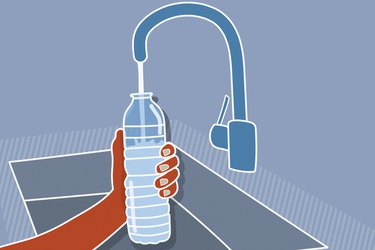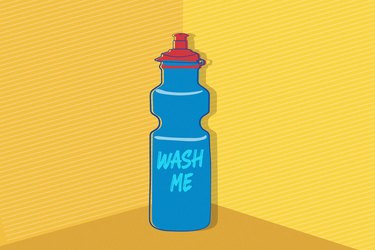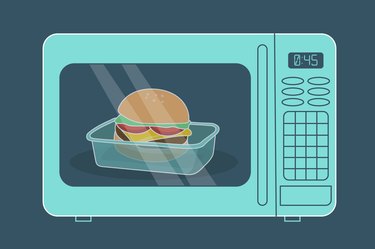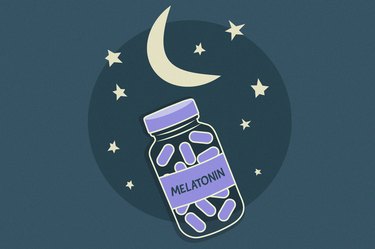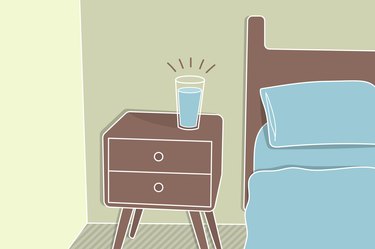
Leaving a glass of water on your nightstand is a relatively common practice. If you wake up thirsty in the middle of the night or morning, you'll be thankful for the readily available H2O.
Expiration dates aren't required on bottled water, so it doesn't necessarily go bad, per the Minnesota Department of Health. But whether or not you should drink stale water that's been sitting out on your nightstand or counter all night — or for hours in a hot car — is up for debate.
Video of the Day
Video of the Day
To find out what can happen if you leave a glass of water out overnight and drink it, we chatted with Kelly Johnson-Arbor, MD, a medical toxicology physician and co-medical director at National Capital Poison Center. Here's what she had to say.
1. It Might Become Contaminated
Without a lid, contaminants can get into your glass of water. "An open glass is susceptible to contamination by dust, germs, insects," Johnson-Arbor says. "This also includes anything else floating or flying in the air."
Your body digests bugs or "anthropods" just like any other food, so this may not actually harm your health as much as it may gross you out, according to the Mayo Clinic.
That said, research shows toxic chemicals can be found in household dust, and over time, taking in high amounts is associated with health problems, per UC Davis.
2. It Might Taste Bitter
If you've ever chugged a glass of water that was left out overnight, you may have noticed the subtle difference in taste. There's an explanation for this, Johnson-Arbor says.
"When you leave a glass of water out overnight, gasses in the air, including carbon dioxide, dissolve in the water," she says. "When carbon dioxide dissolves in water, it is converted to carbonic acid, which is why leftover water might taste bitter."
3. It Can Contain Bacteria
Your mouth is home to about 700 species of microbes, according to the National Institutes of Health (NIH). That's a lot of bacteria.
Drinking from a glass will result in backwash — when liquids mix with the bacteria in your mouth before returning to the container. This is why Johnson-Arbor says you should avoid drinking from a glass of water that was left out overnight if someone else used it before.
"Our mouths contain numerous species of bacteria that can contaminate water bottles or glasses that we drink out of," she says. "While our own bacteria are unlikely to cause harmful effects if we reuse a water bottle or drinking glass after leaving it out overnight, these germs could be harmful to other people and vice versa."
So, How Bad Is It Really to Drink Water That’s Been Out Overnight?
Drinking water that's been out overnight mainly alters the taste but not the safety of the water. Things you might find gross could get in your glass, such as bugs and dust, but these are likely harmless.
"Overall, even though water might not taste as good if it's been left out overnight, it's unlikely to make someone sick," Johnson-Arbor says. "It's generally safe to drink water that has been left out overnight as long as there is no visible contamination of the water."
All of that said, it's wise to note that the longer water sits out at warm temperature — especially after you've touched it or drunk from it — the more likely it is to be contaminated by mouth bacteria or other microbes, as described by an October 2017 study published in the journal Water Research. It's also best to 1) Let the water run for a bit before filling your glass or bottle, to flush contaminants from stagnant pipes and faucets, and 2) Avoid drinking from a reusable cup kept in the bathroom, due to the higher risk of microbial contamination from bioaerosols, as reported by the Virginia Journal of Public Health in 2020.
- Minnesota Department of Health: "Bottled Water: Questions and Answers"
- U.S. Environmental Protection Agency: "Particulate Matter (PM) Basics"
- Acta Biomed: "The effect of temperature and storage time on the migration of antimony from polyethylene terephthalate (PET) into commercial bottled water in Kuwait"
- National Institutes of Health: "Mouth Microbes"
- Mayo Clinic: Should You Worry if You Accidentally Swallow a Bug
- Water Research: "An Experimental Study on the Influence of Water Stagnation and Temperature Change on Water Quality in a Full-Scale Domestic Drinking Water System"
- Virginia Journal of Public Health: "Bioaerosol Effect on Safe Use of Bathroom Appliances for Drinking Water Consumption"

